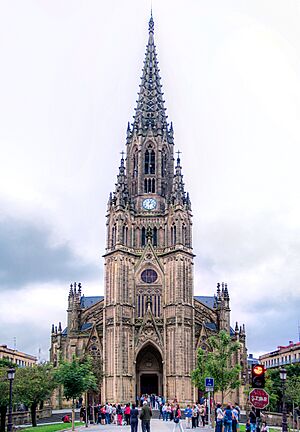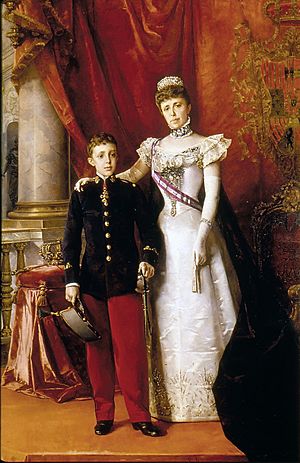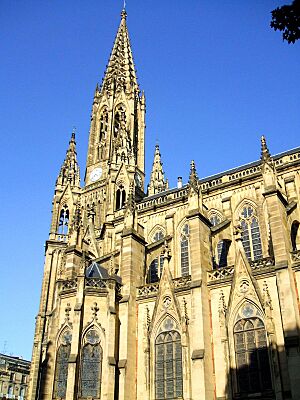San Sebastián Cathedral facts for kids
Quick facts for kids Good Shepherd Cathedral of San SebastiánArtzain Onaren katedrala Catedral del Buen Pastor de San Sebastián |
|
|---|---|
 |
|
| Religion | |
| Affiliation | Roman Catholic |
| Ecclesiastical or organizational status | Cathedral |
| Leadership | Mons. José Ignacio Munilla Aguirre |
| Year consecrated | 30 July 1897 |
| Location | |
| Location | San Sebastián, Spain |
| Architecture | |
| Architect(s) | Manuel de Echave |
| Architectural type | Church |
| Architectural style | Gothic Revival |
| Groundbreaking | 1888 |
| Completed | 1897 |
| Construction cost | 1 500 000 pesetas |
| Specifications | |
| Direction of façade | NW |
| Capacity | 4000 |
| Length | 90 metres (300 ft) |
| Width | 43 metres (141 ft) |
| Width (nave) | 14 metres (46 ft) |
| Height (max) | 25 metres (82 ft) |
| Spire(s) | 1 |
| Spire height | 75 metres (246 ft) |
The Cathedral of the Good Shepherd is a very important church in the city of San Sebastián, Spain. It's located in the Basque Country. This beautiful building is the main church for the Diocese of San Sebastián. It's known for being very tall and is the biggest church in the Gipuzkoa region.
The cathedral was built in the late 1800s. It has a special style called Neo-Gothic, which looks like old Gothic churches. The church is named after the Good Shepherd. It officially became a cathedral in 1953.
Contents
Building the Cathedral
Why a New Church?
In 1881, a new plan was made for churches in San Sebastián. People living in the southern part of the city, in an area called "Ensanche of Amara," had wanted a new church for a long time. So, this plan included creating a new parish (a church area) for them.
In August 1887, the city council gave a piece of land for the church. This land was between the Urumea river and Beach of La Concha. It used to be sand dunes and marshes. Before the main church was ready, a temporary wooden church was built. It was dedicated to the Sacred Heart of Jesus and opened in March 1888.
Choosing the Design
In December 1887, a meeting was held to plan the new church. They decided on a budget of 750,000 pesetas. They also set rules for how many people the church should hold and what its style should be.
Four different designs were presented. The winning design came from a local architect named Manuel de Echave. He was put in charge of overseeing the building work. The new church would be dedicated to the Good Shepherd.
Laying the First Stone
The Spanish royal family was on vacation in San Sebastián at the time. They were invited to help lay the first stone of the new church. This special event happened on September 29, 1888.
The queen regent, Maria Christina, her children, and other important people attended a special church service. After the service, they went to the building site. There, they placed the first stone. Inside the stone was a lead box. It held pictures of the Pope and the royal family, old coins, and copies of newspapers from that time.
The official document for the ceremony was signed by the young king, Alfonso XIII. He was only two years old! His mother had to guide his hand to help him sign. This was his very first signature on an official paper.
Building Materials and Workers
Manuel de Echave supervised the construction. The main builder was José Vicente Mendía, and later Agustín de Zumalabe. The ground had to be carefully drained to make sure it was strong enough for the building.
The stone for the main structure came from the Mount Igeldo quarries nearby. The curved ceilings (vaults) were made from a light stone called tufa from Ocio. The roof slates came all the way from Angers in France. All the workers who built the church were Basques. Local artist Julio Gargallo created the designs for the stone decorations, windows, and spires.
Opening and Completion
After nine years of work, the Church of the Good Shepherd was ready for services. This included a two-year pause because there wasn't enough money. The church was officially opened on July 30, 1897.
The royal family, including Queen Regent María Cristina and King Alfonso XIII, attended the grand ceremony again. The main tower was finished two years later in 1899. In total, building the church cost more than 1,500,000 pesetas. This amount didn't even include the altars and other decorations inside!
Becoming a Cathedral
In 1949, a special order from Pope Pius XII created the Diocese of San Sebastián. This new diocese needed a main church. Because of its beauty and modern design, the Church of the Good Shepherd was chosen.
On July 30, 1953, the church officially became a Cathedral. This happened with the blessing of a new altar. After this, the church underwent four years of changes to fit its new role as a diocesan church. For example, the area around the altar was changed. The original altar, made of cedar wood, was replaced with new choir seats and a statue of the Good Shepherd.
In 1972, more improvements were made for the church's 75th anniversary. Some old altars and the pulpit were removed. The roofs and windows were repaired, and the walls were cleaned. The old wooden floor was replaced with new marble. The lighting inside was also made better, and new benches were installed.
Cathedral Features
The architect Manuel de Echave was inspired by the famous Cologne Cathedral when he designed this church. Here are some interesting facts about its size:
- It covers an area of about 1,915 square meters (20,610 square feet).
- The main part of the church is 25 meters (82 feet) high.
- The main tower reaches 75 meters (246 feet) into the sky.
- The central part of the church is 64 meters (210 feet) long and 36 meters (118 feet) wide at its widest point.
- It can hold up to 4,000 people!
The church is shaped like a Latin cross. It has three long sections and a cross-shaped section (transept). The two ends of the transept have large round windows called rose windows. These windows let in a lot of light. The tall, slender bell tower at the entrance looks very much like the spires of Cologne Cathedral. Many pillars and decorations make the building look even taller.
Inside the Cathedral
The main chapel has simple choir seats. Above them, you can see a sculpture of the Good Shepherd. This sculpture used to be on the original altar. It was made by Joseph Llimona, who also created the statues of the Four Evangelists. These statues are now on the pillars near the center of the church.
There are also other important altars and shrines. These include altars dedicated to the Holy Family, Our Lady of Mount Carmel, Saint Anthony, and Francis of Assisi. These were made by Julio Gargallo. He also worked on the altars for Teresa of Ávila and Our Lady of Perpetual Help.
The Crypt
Underneath the main altar area is the crypt. Since the changes in the 1950s, it has been used as the church's sacristy (a room where priests prepare). The remains of the first parish priest, D. Martín Lorenzo de Urizar, are buried here.
Stained Glass Windows
The beautiful stained glass windows in the cathedral were designed by Juan Bautista Lázaro. They were made by workshops in León and Barcelona. The seven double windows behind the main altar show the twelve apostles and the Sacred Hearts of Jesus and Mary. There are also colorful windows in the baptistry. The rest of the stained glass is in double and triple windows along the side walls. Two large rose windows are at the ends of the transept.
The Organ
The current organ was installed in 1954. At that time, it was said to be the largest organ in Spain and one of the biggest in Europe! It has five keyboards for hands and one for feet, with 106 different sounds (stops). There's also a smaller "echo organ" in the altar area.
The organ has 9,535 pipes, with the largest one measuring 10 meters (33 feet) long. The whole instrument weighs 30 tons! It cost more than 1.5 million pesetas. The organ was built by Organería Española in Azpeitia.
Gallery
See also
 In Spanish: Catedral del Buen Pastor (San Sebastián) para niños
In Spanish: Catedral del Buen Pastor (San Sebastián) para niños










